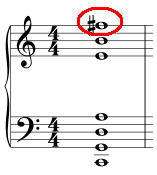Introduction
A question (or two): What would be the most natural scale to play over a CMaj7? What scale would most perfectly capture the “sound” of a CMaj7?
Most people, since the creation of tonal music a few centuries ago, would answer: the C Major scale – but not George Russell. Instead, George Russell came up with his own theory which he called the Lydian Chromatic Concept of Tonal Organisation.
Now, there’s something interesting about the C Major scale when played over a CMaj7 chord. The ‘F’ is an ‘Avoid Note’ – that is, the note F clashes with the chord CMaj7. But is it not a bit strange that there is a note in the C Major Scale that doesn’t quite fit over the CMaj7 chord?
Let’s start with a CMaj7 chord.
- The root note is C.
- Now the strongest, most consonant interval is a ‘Perfect Octave’ (which, incidentally is why it is called ‘Perfect’). This is because an octave is the second harmonic in the harmonic series.
- The next most consonant interval is the ‘Perfect 5th’ (which, again, is why it is called ‘Perfect’). And again this is because the Perfect 5th is the 3rd harmonic in the harmonic series. This is the basis of the Dominant-Tonic relationship – harmonically the strongest possible chord progression.
George Russell says the interval of a Perfect 5th establishes ‘tonal gravity’ which pulls towards the tonic (like a Dominant Chord pulls down to the Tonic Chord). The interval of a Perfect Fifths is the basis of the entire Lydian Chromatic Concept.
Lydian Chromatic Concept
So if a Perfect 5th is the strongest non-root interval, we can build up a harmonically strong scale using intervals of Perfect 5ths. Starting on the C that gives us:
- C → G → D → A → E → B → F#

So we get a scale with all the notes of the C Major scale but with an F# rather than an F – which is a G Major Scale or the C Lydian Mode.
A scale created by stacking Perfect 5ths establishes ‘harmonic order’ whereby each note of the scale is pulled down a 5th by ‘tonal gravity’ back to the tonic (root note). The F# pulls to the B; the B pulls to the E and so on until we reach C.
So by playing C Lydian instead of C Major over a CMaj7 chord, the following things happen:
- We now have a scale with no avoid notes over a CMaj7 chord
- By getting rid of a F, we remove the diatonic tritone interval between the B & F which is the basis of the Dominant chord and thus the Dominant-tonic relationship and thus we have, in a sense, remove tonality itself
- All notes in this scale now work well over the chord without sounding like they need to resolve anywhere
- Each note is related to the next via ‘tonal gravity’ and each tends back to the root note (C)
So we’ve had it wrong for the last 400 years. The scale that fits best fits over a CMaj7 is not C Major but C Lydian (AKA G Major). This theory was very influential. Bill Evans and Miles Davis were influenced by this theory when writing songs for the album Kind of Blue – arguable the most successful Jazz album of all time and one that epitomises Modal Jazz.
Further Study
Now, of course, there is much more to the Lydian Chromatic Concept than this. The full Concept is too complex, convoluted and large to cover here in detail. But the Lydian Chromatic Concept is just a different way of allocating ‘correct’ scales to a particular chord.
Essentially, George Russell came up with seven ‘Vertical Principle Scale‘ based on a ‘Lydian Chromatic Order of Tonal Gravity’:
- Lydian
- Lydian Augmented
- Lydian Diminished
- Lydian♭7 (Lydian Dominant)
- Auxiliary Augmented (Wholetone)
- Auxiliary Diminished (W/H Diminished)
- Auxiliary Diminshed Blues (H/W Diminished)
And four further ‘Horizontal Scales’:
- Major
- Major ♭7
- Major Augmented 5th
- African-American Blues Scale
He then derives chords from each of the degrees of each of the 7 Principle Scales and says you can use any of the 7 Principle Scales or 4 Horizontal Scales over any chord derived from one of the 7 Principle Scales. So, according to Russell, every chord has at least 11 scales that can be used over it – creating different levels of dissonance.
An Example
Say, we have a Cm7♭5 chord and we want to find a scale to use to improvise over this chord. This chord is the #4 chord of the G♭ Lydian Scale. This means we can use the 7 Principle Scales (and 4 Horizontal Scales) from G♭ over this chord (G♭ Lyd, G♭ Lyd Aug, G♭ Lyd Dim, G♭ Lyd♭7, G♭ Aux Aug, G♭ Aux Dim, G♭ Aux Dim Blues + 4 Horizontal Scales). G♭ Lydian will sound the most ‘pleasant’ or ‘consonant’ over this chord, and the most related to the Lydian Tonic of (G♭). The further out you go (Aux Dim, Aux Dim Blues) it will sound more harsh and ‘dissonant’ and less related to the Lydian Tonic of G♭.
But Cm7♭5 is also the VI chord of E♭ Lydian Diminished Scale (E♭ F G♭ A B♭ C D E♭). This means we can use the7 Principle Scales and 4 Horizontal Scales from E♭ over this chord (E♭ Lyd, E♭ Lyd Aug, E♭ Lyd Dim, E♭ Lyd♭7, etc.). But Cm7♭5 is MORE related to G♭ Lydian and LESS related to E♭ Lydian – so will sound more consonant over G♭ and more dissonant over E♭. So you have a choice of 22 different scales you can use to improvise over this one chord.
Lydian Chromatic Concept of Tonal Organisation
That, in a nutshell, is the Lydian Chromatic Concept. If you want more detail – read the book (and Good Luck – it is not an easy read…).